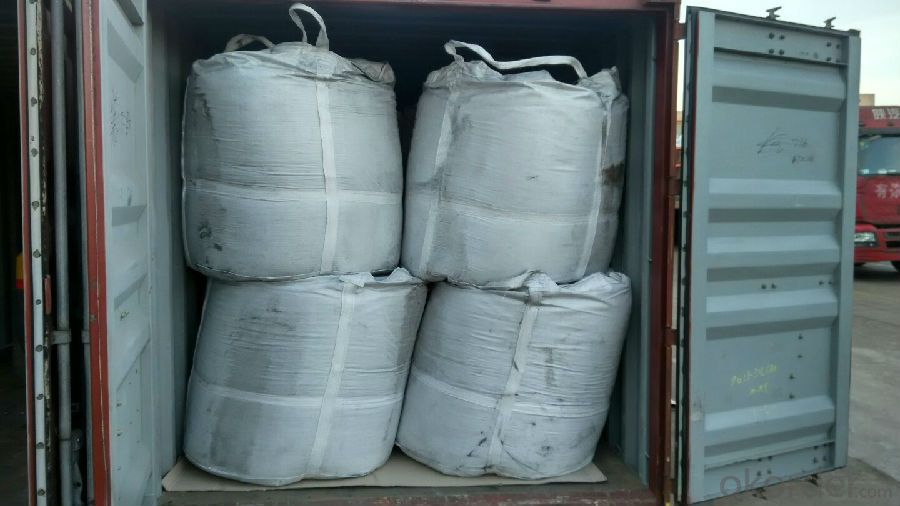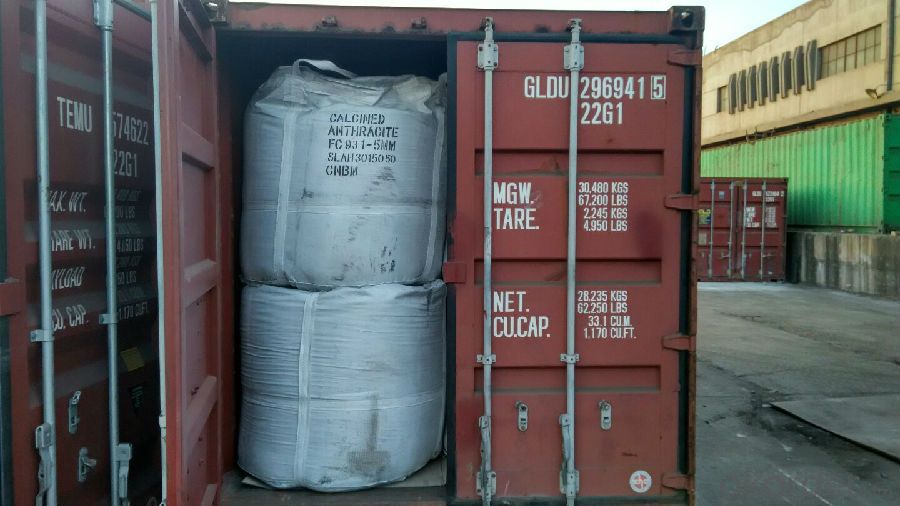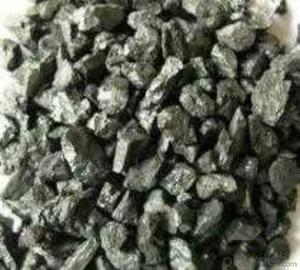FC93 Calcined Anthracite Coal in Low Sulphur as charging coke
- Loading Port:
- Tianjin
- Payment Terms:
- TT or LC
- Min Order Qty:
- 20 m.t.
- Supply Capability:
- 9500 m.t./month
OKorder Service Pledge
OKorder Financial Service
You Might Also Like
Item specifice
Introduction
Carbon Additive/Calcined Anthracite Coal may substitute massively refinery coke or graphite. Meanwhile its cost is much less than the refinery coke and graphite. Carbon Additive is mainly used in electric steel ovens, water filtering, rust removal in shipbuilding and production of carbon material.
Features
Carbon Additive also called Calcined anthracite Coal, Gas Calcined Anthracite Coal, Carbon Raiser, Recarburizer, injection coke, charging coke and etc.
The main raw material of our Carbon Additive is Ningxia unique high quality Taixi anthracite, with characteristic of low ash and low sulfur. Carbon additive has two main usage, fuel and additive. When being used as the carbon additive of steel-smelting, and casting, the fixed carbon may achieve above 95%. it is playing more and more important role in the industry.
Best quality Taixi anthracite as raw materials through high temperature calcined at 1200-1250 ℃ for 24 hours by the DC electric calciner with results in eliminating the moisture and volatile matter from Anthracite efficiently, improving the density and the electric conductivity and strengthening the mechanical strength and anti-oxidation, It has good characteristics with low ash, low resistivity, low carbon and high density. It is the best material for high quality carbon products, it is used as carbon additive in steel industry or fuel.It is becoming more and more popular in the steel industry. We have built a long-term relationship with major steel plants in the world
Specifications
PARAMETER UNIT GUARANTEE VALUE | |||||
F.C.% | 95MIN | 94MIN | 93MIN | 92MIN | 90MIN |
ASH % | 4MAX | 5MAX | 6MAX | 7MAX | 8MAX |
V.M.% | 1 MAX | 1MAX | 1.5MAX | 1.5MAX | 1.5MAX |
SULFUR % | 0.5MAX | 0.5MAX | 0.5MAX | 0.5MAX | 0.5MAX |
MOISTURE % | 0.5MAX | 0.5MAX | 0.5MAX | 0.5MAX | 0.5MAX |
Pictures



FAQ:
What is the packing?
In 25kg bag/ In jumbo bags without pallet/ Two jumbo bags with one pallet/ or as customers’ request
2. What is the production capacity?
10 thousand tons per month
3 What is payment term?
Irrevocable LC at sight/ 20% down payment by T/T and 80% against BL copy byT/T/ or to be discussed
4 What is the service?
We will send sample to the third party(CIQ, CCIC, SGS,BV or to be discussed) for checking, and present the test certificate and loading repot of shipment.
- Q:How does carbon affect the taste of food and beverages?
- The taste of food and beverages can be significantly altered by carbon, which can come in the form of activated charcoal or carbonation. Activated charcoal is known for its ability to absorb impurities and toxins, making it a popular ingredient in various food and drink products. When added to food and beverages, activated charcoal can eliminate unpleasant smells and tastes, resulting in a cleaner and more enjoyable flavor. Carbonation, on the other hand, is widely used in beverages to create a fizzy sensation and enhance the overall sensory experience. By dissolving carbon dioxide gas in liquids under pressure, bubbles are formed when the pressure is released, giving the drink a refreshing and effervescent quality. This carbonation effect can impart a tangy or slightly acidic taste to the beverage, which is often considered pleasant and invigorating. Furthermore, carbonation can also impact the taste of food. For instance, the carbonation found in beer or sparkling wine can help balance the richness of certain dishes, adding a refreshing element and providing a cleanse for the palate. Carbonation can also be incorporated into certain foods, such as bread or pastry dough, to aid in rising and create a lighter texture. It is worth noting that the impact of carbon on the taste of food and beverages can vary depending on the specific application and concentration used. Additionally, the preference for carbonated or charcoal-free options is subjective, as some individuals may prefer non-carbonated alternatives. Ultimately, the use of carbon in culinary applications offers a multitude of possibilities for enhancing taste and providing unique sensory experiences.
- Q:How does carbon affect the electrical conductivity of materials?
- Carbon can affect the electrical conductivity of materials by either increasing or decreasing it, depending on its form and arrangement. In its pure form, carbon can be a semiconductor or an insulator, depending on its crystal structure. However, when carbon atoms are arranged in a specific pattern known as a graphene lattice, it forms a highly conductive material due to its unique electronic properties. Additionally, carbon can also be used as a dopant in semiconductors to enhance their conductivity by introducing impurities into the crystal lattice.
- Q:How is activated carbon produced?
- Activated carbon is produced by heating carbon-rich materials, such as wood, coal, or coconut shells, at high temperatures in the absence of oxygen. This process, known as activation, creates a highly porous material with a large surface area, which gives activated carbon its adsorptive properties.
- Q:How does carbon impact the availability of freshwater resources?
- The availability of freshwater resources is impacted by carbon in several interconnected ways. Climate change is one of the primary means through which carbon affects freshwater availability. The burning of fossil fuels and other human activities result in increased levels of carbon dioxide in the atmosphere, which contributes to global warming. This warming, in turn, leads to changes in precipitation patterns, including alterations in rainfall distribution and intensity. The emission of carbon also leads to warmer temperatures, which can cause higher rates of evaporation and more frequent and severe droughts in specific regions. These droughts reduce the amount of water accessible for freshwater resources like rivers, lakes, and reservoirs. Furthermore, the shifting climate can disrupt natural water cycles, impacting the replenishment of groundwater aquifers, which are essential sources of freshwater. Moreover, the quality of freshwater resources is impacted by carbon. The increased carbon emissions reacting with atmospheric moisture result in acid rain, which acidifies freshwater bodies and renders them unsuitable for many aquatic organisms. This disruption to ecosystems can lead to the loss of species that depend on freshwater resources for their survival. Another manner in which carbon affects freshwater availability is through its influence on land use. The conversion of forests and wetlands into agricultural or urban areas releases carbon stored in vegetation and soil. This not only adds to carbon emissions but also diminishes the ability of natural ecosystems to retain and filter water. Forests, for instance, play a crucial role in maintaining the water cycle by absorbing rainfall and gradually releasing it into streams and groundwater. Deforestation disrupts this process and can result in reduced water availability downstream. In conclusion, carbon emissions have a profound impact on the availability of freshwater resources. Through climate change, carbon alters precipitation patterns, resulting in droughts and decreased water availability. It also affects the quality of freshwater through phenomena like acid rain. Moreover, land-use changes driven by carbon emissions can further diminish freshwater availability by disrupting natural water cycles.
- Q:Power plant water treatment plant, there is a carbon removal device, the expert pointing out what the principle is it?
- The solubility of carbon dioxide gas in water obeys Henry's law, i.e., the solubility of gases in solution is proportional to the partial pressure of the gas on the liquid surface at a given temperature. So only to reduce carbon dioxide gas in contact with the water in the partial pressure of carbon dioxide dissolved in water and free from water will be desorbed, which will remove carbon dioxide free water, carbon remover is the principle of design!
- Q:What are the health effects of carbon pollution?
- The health impacts of carbon pollution, specifically carbon dioxide (CO2) emissions, are wide-ranging and affect both humans and the environment. The primary concern regarding carbon pollution is its contribution to climate change. Because CO2 is a greenhouse gas, it traps heat in the Earth's atmosphere. This leads to global warming and alters weather patterns. As a result, heatwaves, hurricanes, and other extreme weather events become more frequent and severe. These events have direct and indirect effects on health, including heat-related illnesses, injuries, displacement, and the spread of infectious diseases. Furthermore, carbon pollution is closely connected to air pollution, which has significant health consequences. Burning fossil fuels like coal and oil not only releases CO2 but also toxic air pollutants such as sulfur dioxide, nitrogen oxides, particulate matter, and volatile organic compounds. These pollutants can cause respiratory problems like asthma, bronchitis, and other chronic obstructive pulmonary diseases (COPD). They can also trigger cardiovascular issues, increasing the risk of heart attacks and strokes. The health impacts of carbon pollution are not limited to the respiratory and cardiovascular systems. Increased temperatures and changes in precipitation patterns can also affect water and food supplies. This can lead to waterborne diseases, reduced crop yields, malnutrition, and food insecurity. Moreover, carbon pollution has environmental consequences that further worsen health risks. Deforestation reduces clean air availability and the natural carbon sinks that absorb CO2. Ocean acidification damages marine ecosystems, affecting the availability of fish and other seafood, which are essential sources of nutrition for many communities. To minimize the health effects of carbon pollution, it is crucial to reduce greenhouse gas emissions. This can be achieved by transitioning to cleaner and renewable energy sources, implementing energy-efficient practices, and adopting sustainable land-use and agricultural practices. Additionally, investing in healthcare systems and public health infrastructure to address the direct and indirect health impacts of carbon pollution is essential.
- Q:What is carbon black pigment?
- Carbon black pigment, used predominantly as a coloring agent in various applications, is a finely divided form of carbon. It is derived from the incomplete combustion or thermal decomposition of hydrocarbons like coal tar, petroleum, or natural gas, resulting in the formation of extremely small particles with a high surface area. Renowned for its intense black color, high tinting strength, and excellent UV stability, carbon black pigment finds extensive use in the manufacture of inks, paints, coatings, plastics, rubber, and other materials. The particles disperse effectively in these mediums, ensuring a deep and uniform black hue. Apart from its coloring prowess, carbon black pigment boasts several other desirable attributes. It enhances the durability, weather resistance, and electrical conductivity of materials. Additionally, it augments the UV resistance and absorption properties of coatings and plastics, thereby safeguarding against fading and degradation caused by sunlight exposure. Furthermore, carbon black pigment exhibits chemical inertness, rendering it suitable for a wide range of applications without triggering undesirable chemical reactions. It is also non-toxic and has a minimal environmental footprint, making it a preferred choice across multiple industries. In summary, carbon black pigment serves as a versatile and highly utilized additive that imparts deep black coloration, durability, and improved performance to various materials. Its exceptional properties make it an indispensable component in numerous industries, contributing to the production of high-quality products.
- Q:What is the atomic number of carbon?
- The atomic number of carbon is 6.
- Q:How does carbon affect the formation of droughts?
- Carbon dioxide (CO2) and other greenhouse gases play a significant role in the formation of droughts. The increase in carbon emissions from human activities, such as burning fossil fuels and deforestation, has led to a rise in atmospheric CO2 concentrations. This increase in CO2 acts as a heat-trapping blanket, causing the Earth's average temperature to rise, a phenomenon known as global warming. Global warming intensifies the hydrological cycle, which is the process of evaporation, condensation, and precipitation that regulates the availability of water on Earth. As the atmosphere becomes warmer, evaporation rates increase, leading to more moisture being stored in the air. This increased moisture content can result in more intense rainfall events and potentially severe storms in certain regions. However, while there may be an increase in extreme rainfall events, global warming also leads to a reduction in overall precipitation in many areas. Higher temperatures cause increased evaporation from soil, lakes, and rivers, which depletes available water sources. As a result, droughts become more frequent and severe. Additionally, the warming climate alters the patterns of atmospheric circulation, such as the jet stream, which influences weather systems. These changes can result in shifts in precipitation patterns, causing more regions to experience prolonged dry spells and exacerbating the risk of drought. Furthermore, the impacts of carbon emissions and global warming extend beyond the direct effects on precipitation. Rising temperatures also accelerate the rate of evapotranspiration, the process by which water is transferred from the land to the atmosphere through evaporation from the soil and transpiration from plants. This increased evapotranspiration leads to higher water demand from vegetation and crops, which can further contribute to water scarcity and drought conditions. In conclusion, carbon emissions and the resulting global warming significantly affect the formation of droughts. The rise in CO2 concentrations traps heat in the atmosphere, leading to increased evaporation rates, altered atmospheric circulation, and shifts in precipitation patterns. These factors, combined with higher rates of evapotranspiration, result in more frequent and severe droughts. Addressing carbon emissions and mitigating climate change are crucial steps in reducing the risk and impact of droughts in the future.
- Q:What are the consequences of increased carbon emissions on political stability?
- Increased carbon emissions can have significant consequences on political stability. Firstly, it can lead to environmental degradation and natural disasters such as extreme weather events, rising sea levels, and food and water scarcity. These disasters can disrupt economies, displace populations, and create social unrest, ultimately straining political systems. Additionally, carbon-intensive industries often rely on fossil fuels, which can lead to economic disparities and inequality, further fueling social and political tensions. The resulting conflicts over resources, migration, and access to basic needs can undermine political stability and exacerbate existing political challenges. Overall, increased carbon emissions contribute to a range of environmental, economic, and social factors that can erode political stability at local, national, and global levels.
1. Manufacturer Overview |
|
|---|---|
| Location | |
| Year Established | |
| Annual Output Value | |
| Main Markets | |
| Company Certifications | |
2. Manufacturer Certificates |
|
|---|---|
| a) Certification Name | |
| Range | |
| Reference | |
| Validity Period | |
3. Manufacturer Capability |
|
|---|---|
| a)Trade Capacity | |
| Nearest Port | |
| Export Percentage | |
| No.of Employees in Trade Department | |
| Language Spoken: | |
| b)Factory Information | |
| Factory Size: | |
| No. of Production Lines | |
| Contract Manufacturing | |
| Product Price Range | |
Send your message to us
FC93 Calcined Anthracite Coal in Low Sulphur as charging coke
- Loading Port:
- Tianjin
- Payment Terms:
- TT or LC
- Min Order Qty:
- 20 m.t.
- Supply Capability:
- 9500 m.t./month
OKorder Service Pledge
OKorder Financial Service
Similar products
New products
Hot products
Hot Searches





























